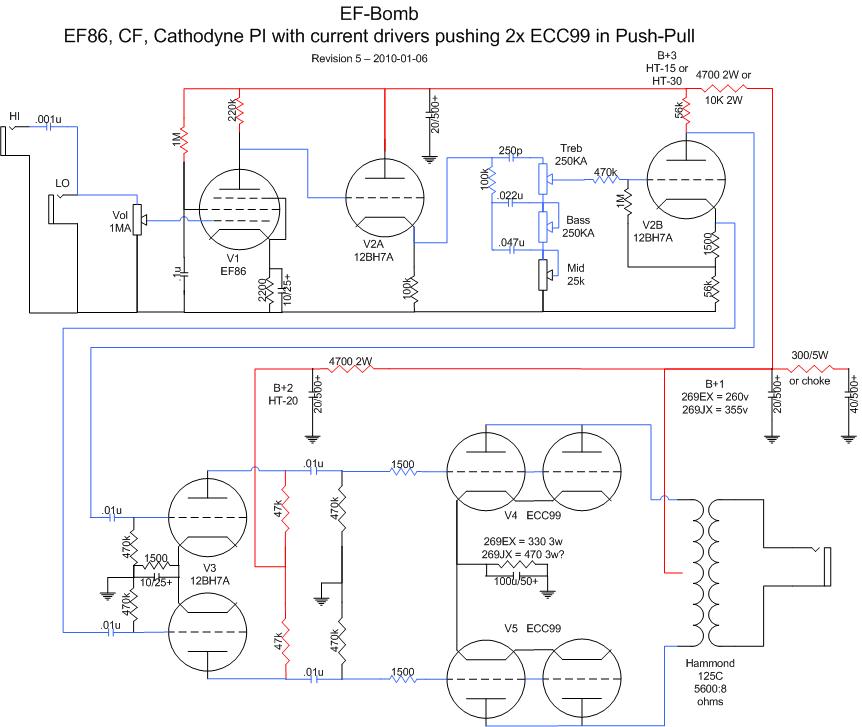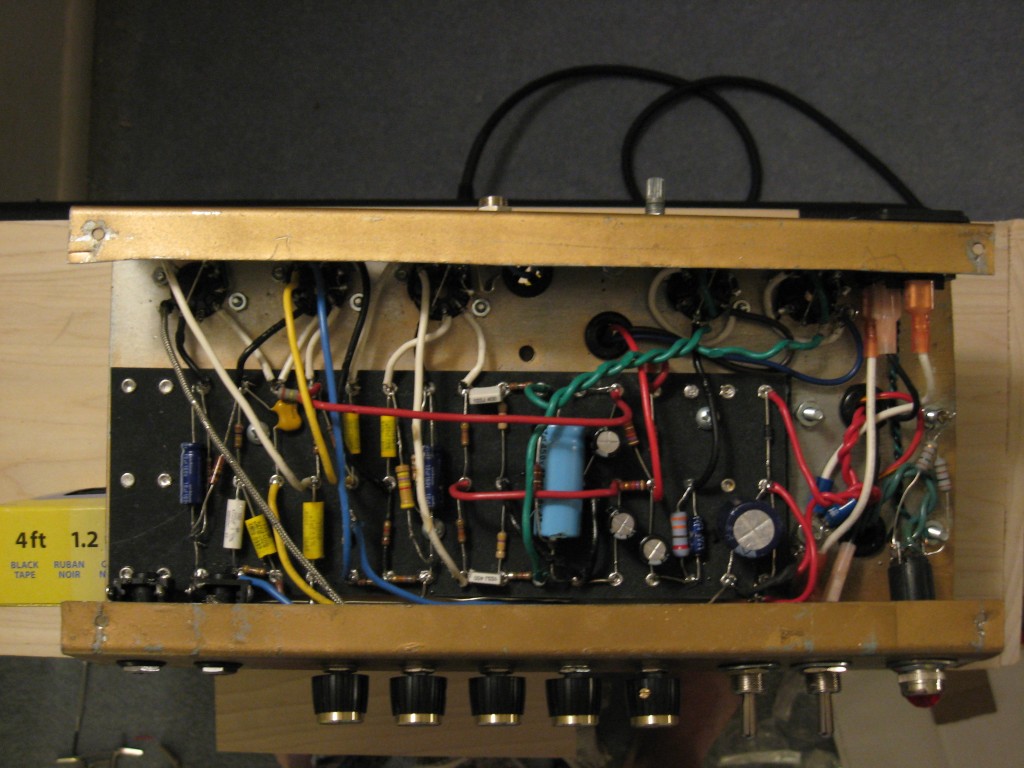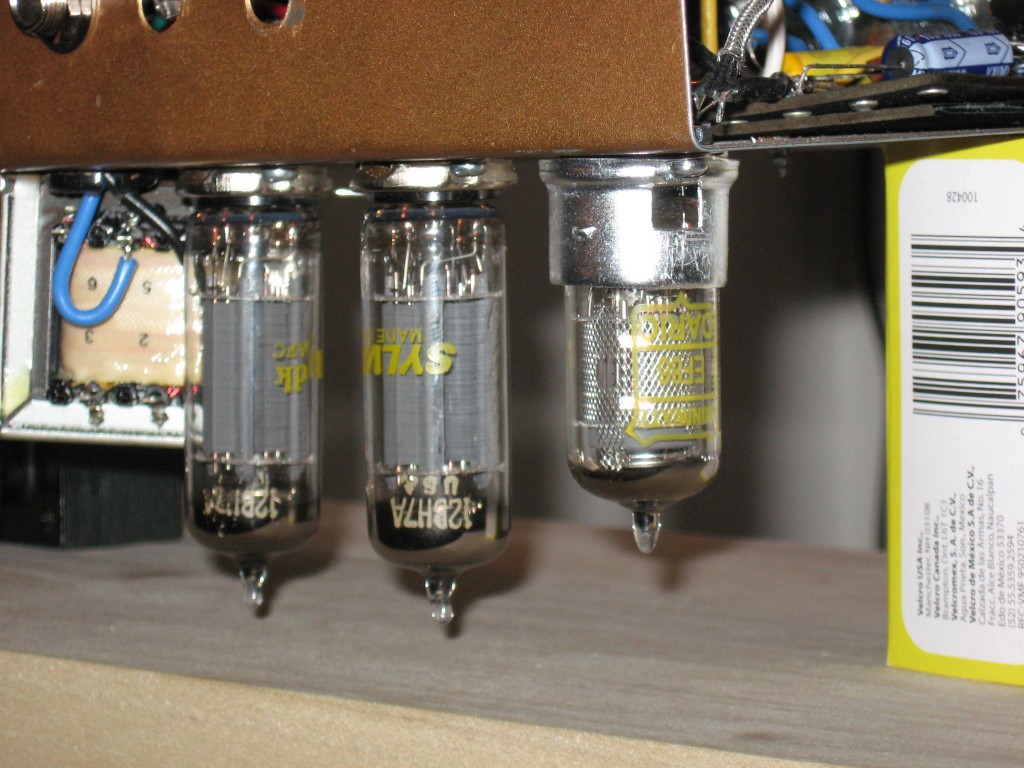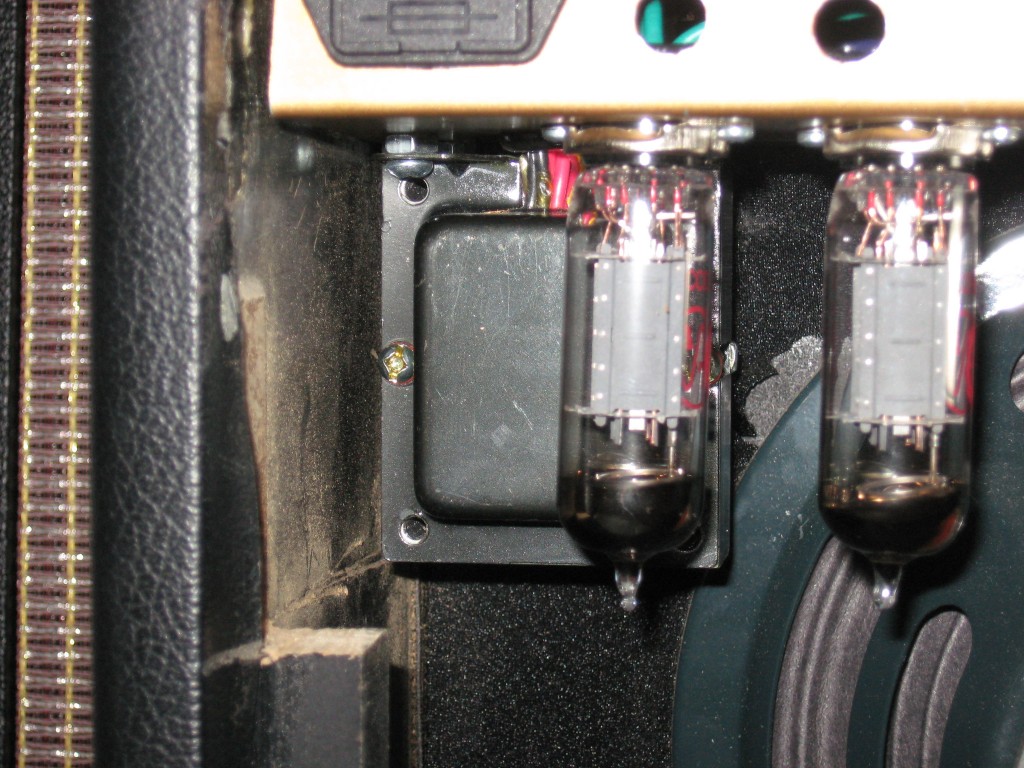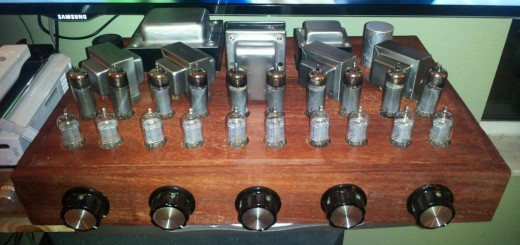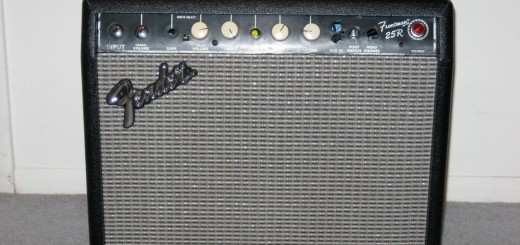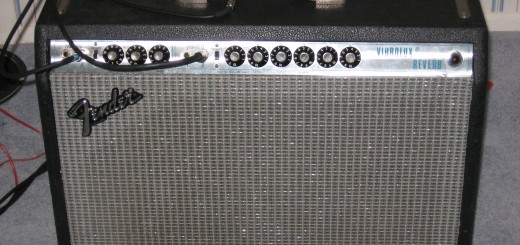Once upon a long time ago I built my own version of an AX84 Firefly and fit it into an old Frontman 15 cabinet. It was okay but not good enough for me to want to play that amp. So one day I decided I wanted a true low-power Marshall and built a 1959/1987 type design into the same Frontman 15 cabinet… That turned out to be one CRAMPED workspace!! To me, the real magic of the JMPs and JCM800s was the quad-output section in the 100-watt models. I wanted to get the same richness but in a package that’s ACTUALLY quiet enough to run at home (unlike an 18-watter). So I decided to use 4 triodes (2x 12BH7A) in push-pull for the power section.
It sounded very good, better than any 5w-or-less Marshall type clone I’ve tried, but not as good as I wanted. After trying countless tweaks and bias changes and grid stopper changes I decided to order some JJ’s ECC99s and give them a shot. On their spec sheet it suggests using them for low-power push-pull output stages, and I hadn’t found anyone on the net who really put them to the test and published their results. The sound was amazing, actually amazing! It roared like a 100-watter but without the bleeding eardrums, with the richness and swirl that only a quad-output can provide. With just one ECC99 the push-pull sounded every bit as good as two 12BH7As, but two ECC99s was just heavenly!
But the amp gave me some trouble. The B+ wasn’t as high as I wanted for a JCM800 preamp, the chassis was way too cramped, I bozo’d the layout, and as a result the noise floor was too high for me to get good recordings. So this little amp sat around for a while, looking cool with its knobs that all go to 11, but it didn’t get much play. I built a true PTP AC15 and fell in love with the magic of a good EF86. But my AC15 didn’t have a tone stack on the EF86 channel and I just HAD to know what it’d sound like with a full tone stack. So I gutted the mini Marshall and set out to create a unique low power amp that would showcase the tone of the EF86 and the dynamics of the ECC99 quad-triode power section. And I was going to do it with 100% spare parts I had laying around. Here’s how the amp I affectionately call the “EF-Bomb” came into being…
The Preamp
It all starts with the EF86. Well, almost. The EF86 is very sensitive to input strength so I decided to place the volume before the EF86. I also didn’t do any RF attenuation on the input because (1) I like the air traffic controllers and Cuban AM radio stations around here, and (2) I didn’t want to suck out any of the signal.
From the EF86 I dumped straight into a 12BH7A cathode follower. This keeps the tone stack’s load off the EF86 so it can keep running in its happy little perfect world. 12BH7As, if you haven’t heard of them before, are basically beefed up 12AU7s with super huge long plates. They’re excellent current drivers and perform well in no-gain situations such as cathode followers without changing the signal as much as 12AX7s do.
The cathode follower drives the tone stack, which is a Fender tone stack with a few value changes. I actually used a 1Ma pot for bass but jumpered it with a 470k resistor (hey, this was a 100% spare parts project!).
Phase Inverter
Next came the phase inverter. I decided to use a concertina PI instead of the typical long-tail because I didn’t want the added gain and coloration that LTPIs produce. The operating range of the 12BH7A’s grid voltage is huge (16v possible swing at the voltages I’m running) so I know this PI can take anything and everything being dished out and split it without distortion. Plus I had a trick up my sleeve…
Post-PI Current Driver
Now this is where I really wanted to break the mold. Reading around various amp building forums I saw a number of people talking about running current drivers into the power tubes but I hadn’t seen anybody actually DO it. The concept sounds good – keep a nice strong signal pushing the power tubes and they’ll in turn run a more consistent current into the output transformer. On paper it should give a richer, clearer, more developed sound at lower volumes. So let’s try it!
Each side of the phase inverter goes through a .01uf coupling cap and into a 12BH7 triode, biased more for current than gain. After initial build I was getting some strange behavior and it took me a while to track it down. For some reason the triode connected to the cathode-side of the phase inverter was getting to some sort of grid-bias condition and it was causing the two halves of the signal to be way out of balance – like 90%/10%. I tried multiple tubes and had the problem no matter what type of tube was in there. Running a 100k ground reference resistor brought the two sides to the closest balance and solved the problem.
Output
And finally the signal passes .01uf coupling caps, a 470k ohm ground reference and hit a 1500 ohm grid stopper on each phase before going into the 4 ECC99 triodes. They are cathode-biased with a 330-ohm 3-watt resistor bypassed by a 22uf/35v cap. It goes into a Hammond 125C output transformer at 5600 ohms and out to 4-ohm and 8-ohm secondary taps. I’m using a little Jensen C8R which does a better job than expected.
Power
I used a Hammond 269EX for the power supply; the same one that powered the original Firefly. If I was spending money on the project I would’ve chosen a higher voltage secondary to get a higher B+. The ECC99s and 12BH7As can operate at 400v so there’s definitely more potential headroom available.
The Result
As it is it’s a surprisingly clean amp, and the tone at low volume is fully developed and very musical. Once that volume knob gets up around 7 or 8 it has this big, Big, BIG overdrive sound that leaves me wondering how a single 8″ speaker with 5 watts of signal could possibly be making all that music! With a bigger speaker it sounds even better, but the tone can start to get a little bassy. That’s why the “high” input is a high-pass filter, to reduce the low end when using a larger speaker.
Lessons Learned
Don’t build an EF86 into a combo, ever. EVER. EVER!!! I did it only because I already had the chassis loaded and ready to go, but the natural microphonics of all EF86s are a problem. In this design the only attenuation between the EF86 and the speaker is the tone stack, and because of that every microphonic nuance comes through the amp at full volume. I have tried quite a few variations to remedy this but in the end I ALWAYS get some degree of rattle when playing with the internal speaker. Using an external speaker is MUCH better and microphonic rattle only becomes an issue if the amp is mic’d and going through a PA.
Get a decent output transformer. At first I tried a cheap no-name P/P OT that Antique Electronics sells, and it got TROUNCED by a tiny 3-watt Hammond 125A!! The 125C sounds great and it definitely doesn’t break the bank.
More Power Filtration is a GOOD thing. I tried by starting with 8uf caps like some Vox designs (but of course I didn’t use a choke) and the hum was pretty bad. I put in bigger filter caps and it made an immediate difference.
Finally, Sound clips!
Here are three minutes of your life you’ll never get back. It’s just random messing around with my Yamaha SA2200 and the EF-Bomb. The left channel is a Sennheiser e609 up close to the speaker, the right channel is a condenser mic picking up the whole room. A little bit of compression and EQ to balance out the channels, but otherwise no effects.

